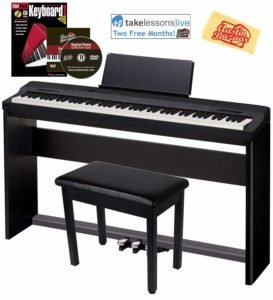A digital stage piano is a must for any concert hall or venue. If you want a high quality digital piano for your own performance use, you should ensure that you think carefully about the features that you may need.

Portability First of all, you will need to think about how portable you need the piano to be. Whilst some musicians travel from venue to venue with their instruments, there are others who play in just one venue, for example those who play at restaurants or a cabaret bar as a resident musician.
If you will not need to travel with your digital piano, you may want to choose an upright digital stage piano, as these really do look the part. If you need to travel however, you should choose a piano that comes with a foldable stand so that you can store it easily and carry it whilst you are traveling.
Remember that upright pianos take up a lot of space and they can’t be easily stored away so even if you have a stationary location for the piano to stand, you will need to leave it there. For this reason, even if you will be leaving the piano in the same venue permanently, you may still need to consider purchasing a slightly more portable solution that can be sorted away when needed.
Sound Quality You should ensure that you choose a digital piano that has realistic voices and effects. Weighted keys will allow you to play the piano as you would play an authentic piano with softer and harder notes.
You should also look for the value of the polyphony. The higher the polyphony, the more sound clarity that you can expect to get from the piano. Features When you purchase your digital piano, you will be able to take advantage of various features.
The more money you are willing to spend, the more flexibility you will have with choosing the features that you need. Pedals – Some digital stage pianos come with damper pedal systems. You can get 2 or 3 pedal dampers and these help add realistic effects to your music.
Dual and Split Keyboard – you can sometimes split the keyboard in two so that a different instrument can be assigned to each side. Alternatively, dual mode allows the keyboard to be split so that two players can have their own section of the keyboard to play.
Effects – Chorus, reverb and equalizer features allow you to add effects to your music. Recording – So that you can record your performances and play them back, you should look out for the pianos that offer recording capabilities and the most possible memory. Some even allow you to plug the piano into your computer so that you can save your recordings for later use.
Types of Pianos
The piano is such an interesting Instrument in that there are so many different types to choose from. Read on if you would like to learn about the types of the piano is that you can find.

Vertical pianos are so-called due to the height and the positioning of their strings. They are the most common type of piano as they are not expensive to purchase, are fairly small, and produce a good sound. These planners feature dampers and strings that run vertically as well as hammers and dampers that run horizontally.
A soundboard is used and this has wooden reinforcements. These planners are also known as bright colours and they come with a variety of price tax from some of the cheapest piano is that you can find on the market today right up too expensive high-quality pianos that can rival the cost of some of the best grand pianos.
Types of PianosFor those who only have a small amount of space for piano, the spinet is often a popular choice. This piano, however, tends to be quite inexpensive and due to its size it is not very accurate in its performance.
You also have to tune this kind of piano frequently. The console piano is slightly larger than a spinet piano. These pianos have a richer tone as they have direct action keys. If you have ever seen a piano in a school or studio, it is more than likely that you have seen a studio piano.
These types of piano have a larger soundboard with more keys. These pianos produce a Great tone and quality when they are played. The tallest of all upright pianos is the full-size piano. These are not very popular anymore due to their size and weight although you may have seen them in museums.
Even though they are not so popular anymore they do tend to stay in tune very well. They also have the great tone that never seems to diminish. Grand pianos are the most impressive looking pianos around. They are also the most expensive.
They are characterised by their classic shape as well as a lid that can be opened to produce a more richer and projected sound. Grand pianos have a standard number of 88 keys. The petite grand piano is the smallest of all grand and indeed upright pianos.
Despite their small size, they are still powerful and produce a rich and clear tone. The baby grand piano is highly popular. It has a beautiful sound quality and also looks impressive. Due to a smaller size, it is also affordable and does not take up as much space as some of the larger grand pianos.
The largest of all pianos and indeed grand pianos is the concert grand. This is an impressive piano that is not only majestic but also produces an amazing tone that can be projected across a hall. Digital pianos and keyboards are all electric pianos that have varying degrees of quality.
If you choose the right digital piano, you can find that you can replicate all of the above pianos in sound thanks to the multiple voices that are pre-programmed with the Digital piano. This makes digital piano and is a great alternative to acoustic pianos. Digital pianos and keyboards are also highly portable – something that cannot be said about acoustic pianos.
Engineering of a Stage Piano

Stage pianos are usually built with the best specifications companies usually have to offer, and are able to perform at the highest of capabilities, too. These pianos are usually fitted with the best hammer action technologies and keyboard systems, trying to replicate the reality of a real piano or the ease or difficulty of playing a real board.
This is one area where manufacturers may again make a tradeoff, as some piano players want the most realistic playing experience while others want a softer and easier board that will allow them to play even faster than would be expected on a real piano.
Some examples of the hammer action systems on stage pianos would be the Tri-Sensor hammer action of the Casio Privia series, the Progressive Hammer Action (PHA) series of the Roland, or the Graded Hammer action series of Yamaha. The implemented key action usually depends on the level and price range of the piano.
Stage pianos also have the best sampling and tone generation systems of most pianos, as these are really the heart of any digital piano. As mentioned before, stage pianos are mostly geared towards the live performance and bringing the most realistic sound of an instrument, so nothing less than the best is expected here. More at https://www.brandreviewly.com/best-digital-pianos/ .
These tone generation sound engines work hand in hand with sampling and layering of the machine and the specific playing style of the player to produce a very realistic experience.
Some examples of the sound engines used by various companies are the SuperNATURAL Piano sound engine from Roland, The CFX, Real Grand Expression (RGE), Pure CF series sound engines from Yamaha, and the Acoustic and Intelligent Resonator (AiR) sound source found in many Casio models, including their Privia series. More at https://www.brandreviewly.com/.






